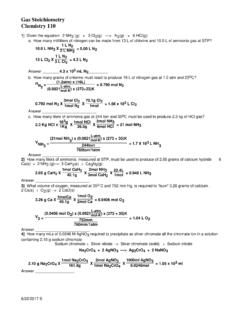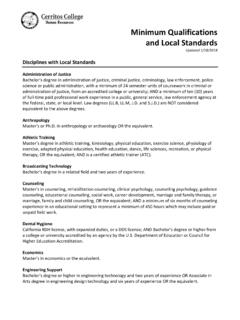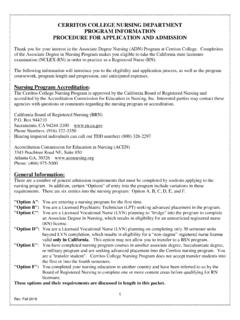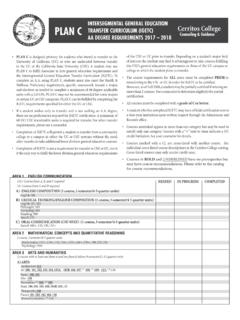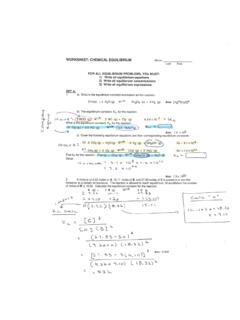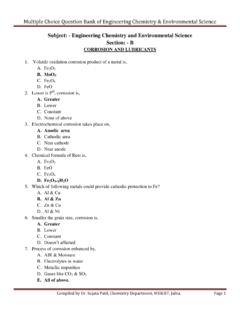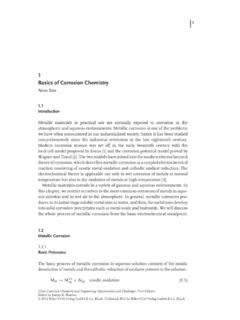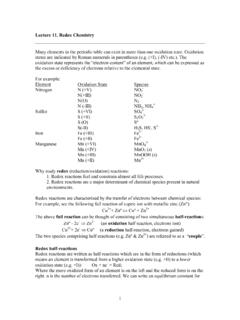Transcription of Grignard Reaction: Synthesis of ... - Cerritos College
1 *NOTE: Grignard reactions are very moisture sensitive, so all the glassware in the reaction (excluding the work-up) should be dried in an oven with a temperature of > 100oC overnight. The following items require oven drying. They should be placed in a 150mL beaker, all labeled with a permanent marker. 1. 5mL conical vial (AKA: Distillation receiver). 2. Magnetic spin vane. 3. Claisen head. 4. Three Pasteur pipettes. 5. Two 1-dram vials (Caps EXCLUDED). 6. One 2-dram vial (Caps EXCLUDED). 7. Glass stirring rod 8. Adaptor (19 ) Grignard Reaction: Synthesis of Triphenylmethanol Pre-Lab: In the equations section, besides the main equations, also: 1) draw the equation for the production of the byproduct, Biphenyl.
2 2) what other byproduct might occur in the reaction? Why? In the observation section, draw data tables in the corresponding places, each with 2 columns -- one for prediction (by answering the following questions) and one for actual drops or observation. 1) How many drops of bromobenzene should you add? 2) How many drops of ether will you add to flask 2? 3) 100 L is approximately how many drops? 4) What are the four signs of a chemical reaction? (Think back to Chem. 110) 5) How do the signs of a chemical reaction apply to this lab? The Grignard reaction is a useful synthetic procedure for forming new carbon- carbon bonds. This organometallic chemical reaction involves alkyl- or aryl-magnesium halides, known as Grignard Grignard reagents are formed via the action of an alkyl or aryl halide on magnesium metal.
3 2 Grignard reagents react with electrophilic chemical compounds such as carbonyl groups. The addition of the Grignard reagent to the carbonyl typically proceeds through a six-membered ring transition state as shown in Figure Figure 1: The six-membered ring transition state for a Grignard reaction. The addition to the nucleophile is irreversible due to the high pKa value of the alkyl component (pKa = ~45). Note that such reactions are not ionic; but that the Grignard reagent exists as an organometallic cluster (in ethereal solvents). The reaction is conducted by adding the organic halide to a suspension of magnesium in an ether, which provides ligands required to stabilize the organomagnesium compound.
4 Typical solvents are diethyl ether and tetrahydrofuran. The disadvantage of the Grignard reagents is that they readily react with protic solvents (such as water), or functional groups with acidic protons, such as alcohols and amines. In fact, atmospheric water in the lab can dictate one's success when trying to synthesize a Grignard reagent from magnesium turnings and an alkyl halide. To circumvent this issue, the reaction vessel is often dried to evaporate all moisture, and then sealed to prevent more from entering. Grignard reactions often start slowly. As is common for reactions involving solids and solution, initiation follows an induction period during which reactive magnesium becomes exposed to the organic reagents.
5 After this induction period, the reactions can be highly exothermic. Many methods have been developed to initiate sluggish Grignard reactions . Mechanical methods include crushing of the Magnesium pieces in situ; rapid stirring and sonication of the suspension are also effective. Common chemical methods for initiation include the addition of small amounts of iodine, methyl iodide, or 1,2-dibromoethane. The amount of Mg consumed by these activating agents is usually insignificant. This Synthesis begins with the formation of the Grignard reagent from bromobenzene in ether in the presence of crushed magnesium turnings. All equipment and solutions must be kept completely free of water. Once the Grignard reagent, phenyl magnesium bromide, is formed, the benzophenone is added.
6 This forms the alkoxide which is protonated with acid to give the alcohol. The overall reaction is shown in Figure 2 Figure 2: The overall reaction sequence. Procedure: FLASKS: Flask #1: Your ether storage: The 2-dram vial. Flask #2: Bromobenzene storage: A 1-dram vial. Flask #3: Reaction Flask: The 5mL conical vial. Flask #4: benzophenone storage: A 1-dram vial. *REACTION PROCEDURE: I. Generation of the Grignard Reagent: 1. Remove the dried glassware set from the oven. Cap them as quickly as possible once taken out of the oven. As soon as it is cool enough to handle, assemble the 5mL conical vial, the Claisen head, and the Drierite-charged drying tube, according to Figure 3 above.
7 2. Flask1: Fill up with dry diethyl ether. 3. Flask 2: Fill Flask #2 with 76 l of bromobenzene (Approximate the volume assuming that 20 drops equals 1mL in order to minimize/avoid inhaling the vapors and adding water). Add of ether from flask 1. Cap and mix the contents. 4. Flask 3: Using a pair of tweezers place 3 pieces of dried magnesium turnings (in excess) in flask 3. Add 100 l of the solution from flask 2, followed by a small grain of iodine (serving as a kind of catalyst, one chemical method to initiate sluggish Grignard reactions ). At this point, the magnesium turnings should be covered by the added solution. If no, add enough ether to cover the magnesium, but not too much or it will be too dilute.
8 5. With the dried stirring rod press gently on the magnesium turnings in order to break their surface and to expose the fresh, unoxidized magnesium metal to the reaction mixture. 6. Immediately assemble the apparatus and start to heat it gently. Before adding the remaining bromobenzene solution, you should observe signs of reaction initiation in the flask 3. These signs include appearance of bubbles on the Mg surface, cloudiness and disappearance of the purple iodine color. 7. NOTE: Since ether is a low-boiling solvent, it is important to keep the reaction mixture from running dry of ether. Keep a close eye on the level of the reaction mixture and replenish any lost ether by adding more fresh ether from flask 1 with needle.
9 (Do not open the rubber cap). On the other hand, adding too much ether may drastically lower the concentrations of the reacting species and slow down or stop the reaction. 8. After the reaction is initiated, quickly add the spin vane in order to have constant stirring and then add the remainder of the bromobenzene solution drop-wise while stirring and gently heating. 9. After the addition of bromobenzene is complete, transfer 300 L of dry diethyl ether into flask 2, mix and dissolve any leftover bromobenzene and add it to the reaction flask. Keep stirring for 5 more minutes. II. Addition of Benzophenone: 10. Prepare a solution of 105 mg of benzophenone (you can use the same needle that you have been using, no need of rinsing) in 300 L of diethyl ether in flask 4.
10 11. When the 5 minutes of stirring (from part 1) is completed, add the benzophenone solution to the reaction over a 30 second-period, drop- wise (reaction is very quick. You should add it slowly. Don t get too hot). The rate of addition should be such that a gentle reflux is never exceeded (you should not see bubbling). 12. Dissolve any remaining benzophenone with 300 L of dried ether and add it to the reaction flask to increase the yield. Keep stirring for 5-10 minutes. Detach the reaction flask and let cool. *WORK-UP PROCEDURE: 13. Add ml aqueous HCl drop-wise and stir to neutralize the solution and make alcohol. (If you don t have enough to see two layers, add more ether). Cap, shake and let settle.
